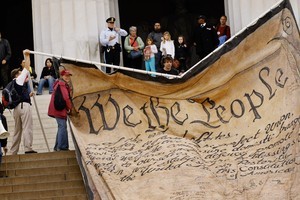 Labor Day weekend is arriving again. Here is history of organized labor that is called unions or trade unions. President Trump has done quite a lot to improve our economy and present more opportunities for Americans. However, the heroes are the every day folks who work diligently to support their families and make America productive - We the People.
Labor Day weekend is arriving again. Here is history of organized labor that is called unions or trade unions. President Trump has done quite a lot to improve our economy and present more opportunities for Americans. However, the heroes are the every day folks who work diligently to support their families and make America productive - We the People.During the 1850s, improving economic conditions led to the first national labor unions. The typesetters, iron molders, hat finishers, stone-cutters, and cigar makers all formed permanent groups. When the Civil War followed, labor shortages encouraged other groups to create their own unions. During and immediately after the war, railroad workers formed brotherhoods; locomotive engineers unionized in 1863, conductors in 1868, and firefighters in 1873. Other artisan professions joined in unions but fell victim to the industrial changes after the war. The Knights of St. Crispin started in 1867 as an association of shoemakers; the introduction of shoe-making machinery doomed the union to extinction within a decade.
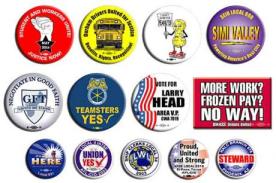 The viability of national unions encouraged the creation of a national organization of labor. In 1866, the National Labor Union established in Baltimore. It consisted of national unions of various kinds of workers under the general leadership of William Sylvis,
head of the iron molders. The union concentrated on national political
action, including lobbying for an eight-hour day. The National Labor
Union was the first organized labor body in the United States to make
contact with its counterparts in Europe. Sylvis’ death in 1869 caused
many unions to withdraw from the organization, however. In 1872, the
union transformed itself into the National Labor Reform Party and fell into decline. The decline completed by the depression that followed the Panic of 1873. Of 30 national unions existing in 1872, fewer than 10 survived.
The viability of national unions encouraged the creation of a national organization of labor. In 1866, the National Labor Union established in Baltimore. It consisted of national unions of various kinds of workers under the general leadership of William Sylvis,
head of the iron molders. The union concentrated on national political
action, including lobbying for an eight-hour day. The National Labor
Union was the first organized labor body in the United States to make
contact with its counterparts in Europe. Sylvis’ death in 1869 caused
many unions to withdraw from the organization, however. In 1872, the
union transformed itself into the National Labor Reform Party and fell into decline. The decline completed by the depression that followed the Panic of 1873. Of 30 national unions existing in 1872, fewer than 10 survived.The economic downturn led to labor-related violence during the 1870s and 1880s. With the disappearance of the miners’ union in Pennsylvania, violence between miners and the hired police of mine owners resulted. Irish immigrants, labeled “Molly Maguires” by the press, were blamed and a number hanged for murder. Strikes by railroad workers in 1877 harmed the national economy and caused more violence. President Rutherford B. Hayes dispatched federal troops to keep order in West Virginia. The climax in Pittsburgh was a pitched battle that left 26 people dead.
The most important labor union during the 1880s was the Knights of Labor. The union was organized as a secret society among garment cutters. After the violence of 1877, the Knights gained more followers. After renouncing its secrecy, the union soon had 19,000 members. Unlike earlier unions, the Knights was highly centralized and included all professions. By 1886, the Knights of Labor was a national labor union with more than 700,000 members. The Knights had a rapid decline, however, thanks mostly to violence connected to the Haymarket Square Riot. By 1893, it had virtually ceased to exist as a labor union. The Knights’ legacy, however, included the creation of a federal Bureau of Labor and legislation regulating the settlement of railroad strikes.
After 1886, many labor leaders realized that the English model of a labor union would be more successful. They organized job and skill-oriented unions, with central control over locals, effective collection of strike funds, and concern only with the immediate economic objectives of the workers. The foremost leader in this movement was Samuel Gompers of the Cigar-makers Union.
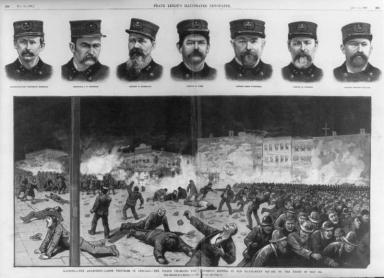 Gompers was the driving force behind the organization of the American Federation of Labor (AFL) in 1886. The AFL was an organization of autonomous trade unions,
and the central administration resolved jurisdiction questions and
promoted common interests. Gompers served as president of the AFL from
1886 to 1924, with the exception of only one year. He stayed away from
independent political action and only lobbied on behalf of the members.
Because membership was restricted to skilled workers, the AFL’s
membership grew at a slower rate than the labor force.
Gompers was the driving force behind the organization of the American Federation of Labor (AFL) in 1886. The AFL was an organization of autonomous trade unions,
and the central administration resolved jurisdiction questions and
promoted common interests. Gompers served as president of the AFL from
1886 to 1924, with the exception of only one year. He stayed away from
independent political action and only lobbied on behalf of the members.
Because membership was restricted to skilled workers, the AFL’s
membership grew at a slower rate than the labor force.Unskilled workers were attracted to socialist organizations or other unions. The most notable was the American Railway Union, open to both skilled and unskilled railroad workers. The founder of that union, Eugene V. Debs, later gained notoriety for his socialist ideas.
Labor violence reached new heights during the 1890s. In 1892, the violent Homestead strike in Pennsylvania pitted strikers against Pinkerton detectives, and a number of lives were lost. In 1894, the American Railway Union struck the Pullman Palace Car Company. Members of the union refused to handle trains using Pullman cars. Railroad traffic in the United States ground largely to a halt. Citing the union’s obstruction of federal mail service and interstate commerce, Attorney General Richard Olney obtained an injunction against the union. Debs was imprisoned, and federal troops broke the strike. The right of judges to issue injunctions to stop labor actions was upheld by the U.S. Supreme Court.
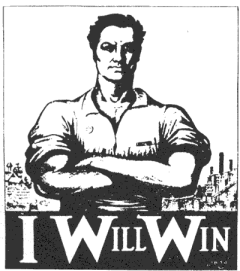 In June 1905, representatives of unskilled workers formed the Industrial Workers of the World
(IWW), or “Wobblies.” Socialist influences in the IWW alienated many
Americans, however. During World War I, the union’s leaders were
prosecuted, and the union was largely destroyed. Many members joined
more radical groups, including the Communist Party.
In June 1905, representatives of unskilled workers formed the Industrial Workers of the World
(IWW), or “Wobblies.” Socialist influences in the IWW alienated many
Americans, however. During World War I, the union’s leaders were
prosecuted, and the union was largely destroyed. Many members joined
more radical groups, including the Communist Party.The first African-American-controlled union was the Brotherhood of Sleeping Car Porters. By the mid-1920s, more than 20,000 African-Americans worked as porters. The Pullman Company, for which most worked, strongly discouraged its employees from organizing to negotiate for fewer hours and more pay. In fact, those employees who did attempt to form a union found themselves without a job. Therefore, Pullman Company porters turned to A. Philip Randolph, an African-American who was not employed by the company, to organize on their behalf. In 1925, Randolph created the Brotherhood of Sleeping Car Porters. However, 12 years lapsed before any significant changes were made. In 1936, the Brotherhood of Sleeping Car Porters was officially recognized by the AFL, and a year later, the union received its first labor contract—the first contract between an American company and a black union—which decreased work hours and increased wages.
The first two decades of the 20th century witnessed a changing attitude toward workers. States began passing laws that regulated working conditions and limited child labor. Those laws were tested before the courts, which eventually constructed a formula for their constitutionality. Federal laws friendly to labor were also passed. Most notably, a Department of Labor was created in 1913 with William B. Wilson, a former union leader, appointed secretary. During World War I, organized labor supported the war effort and was rewarded by greater input in decisions and policies.
After the war, an anti-labor movement swept the United States. Court decisions overturned anti-injunction and minimum wage laws. Union membership dropped from 5 million in 1921 to 3.4 million in 1929. Aggressive anti-union activities by employers included expansion of benefits like health insurance to non-union workers and helped reduce the perceived need for unions. Communists seeking power in the unions also challenged traditional leadership during this time. When the Great Depression hit in 1929, organized labor was ill prepared.
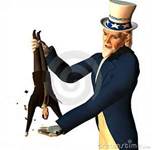 Unions lost members during the depression, but the election of President Franklin D. Roosevelt
and the start of the New Deal signaled a renaissance for organized
labor. Direct grants to states were made, and labor-friendly legislation
was pushed through Congress. While putting people back to work, the
federal government also instituted reforms based on those in Europe.
Fair labor standards were established for government contractors, while
minimum wages and maximum hours were legislated in 1938. The Social Security Act (1935) provided unemployment insurance as well as old age and survivors’ insurance. The National Labor Relations Board
was established, and workers were given the right to organize and
bargain collectively without interference from employers. Union
membership rapidly increased.
Unions lost members during the depression, but the election of President Franklin D. Roosevelt
and the start of the New Deal signaled a renaissance for organized
labor. Direct grants to states were made, and labor-friendly legislation
was pushed through Congress. While putting people back to work, the
federal government also instituted reforms based on those in Europe.
Fair labor standards were established for government contractors, while
minimum wages and maximum hours were legislated in 1938. The Social Security Act (1935) provided unemployment insurance as well as old age and survivors’ insurance. The National Labor Relations Board
was established, and workers were given the right to organize and
bargain collectively without interference from employers. Union
membership rapidly increased.At the 1935 AFL convention, reformers demanded that workers in mass production industries be organized. When the majority refused, the dissidents organized the Congress of Industrial Organizations (CIO) under the leadership of John L. Lewis. Lewis aggressively worked to organize automobile and steel workers. The members adopted the new tactic of sit-down strikes; during which workers refused to leave the factories or do work. Owners were unable to bring in strike breakers to continue production. Bloody violence occurred, but by 1941, the major industries were unionized.
Labor recognized the debt it owed to Roosevelt and supported his reelection in 1936. When the United States entered World War II, organized labor played an important role in ensuring that production remained steady. Few strikes occurred, although those that did led to a weakening of support for unions. Unions were also faced with the challenge of increasing numbers of women and African-Americans joining the workforce. Nondiscrimination was ordered in all government contracts after May 1943, but that was only the first step in opening unions to minorities.
After the war ended, labor’s image soon became tarnished. During the economic dislocation after the war, many strikes occurred. President Harry Truman used his powers to deal firmly with those he felt threatened national security, but generally, unions were able to get the wage increases they requested. The discovery of communists among union leaders also harmed unions. Evidence of union corruption was also found. The changing atmosphere toward organized labor was reflected in the passage of the Taft-Hartley Act in June 1947. The act strengthened employers’ rights and restricted many union activities.
Labor Unions = Also known as a trade union, a labor union is an association of laborers with the purpose of gaining better working conditions and wages. Unions, which organized according to occupation or industry, engage in collective bargaining with employers and sometimes stage strikes.
Collective Bargaining = Collective bargaining is the name given to negotiations between employers and labor unions over working conditions and wages.
Closed Shop = A closed shop is a company in which all the employees are union members, and being a member of a union is a condition of employment. The employer is required to hire only union members except in cases where a union member is not available. In such situations, a non-union worker may be hired with the requirement that he or she become a union member once employed.
Lobbying = the most common method of shaping public policy in the United States, lobbying embodies the formal, organized attempt to influence legislation. Lobbying is carried out through a variety of means, but for the most part, lobbyists directly contact legislators and their staffs in an attempt to influence congressional votes.
Sit-Down Strike = the sit-down strike was part of a new strategy adopted by labor organizers in the 1930s; as the name implies, workers simply sat down in the factory and refused to leave. Workers at companies like General Motors and Firestone effectively used the sit-down strike, as did glass and textile workers, electricians, dressmakers, and waitresses.
SOURCES
“organized labor.” American History. 2006. ABC-CLIO. 14 Nov. 2006- .Conservapedia
Discover the Networks
Right to Work



No comments:
Post a Comment